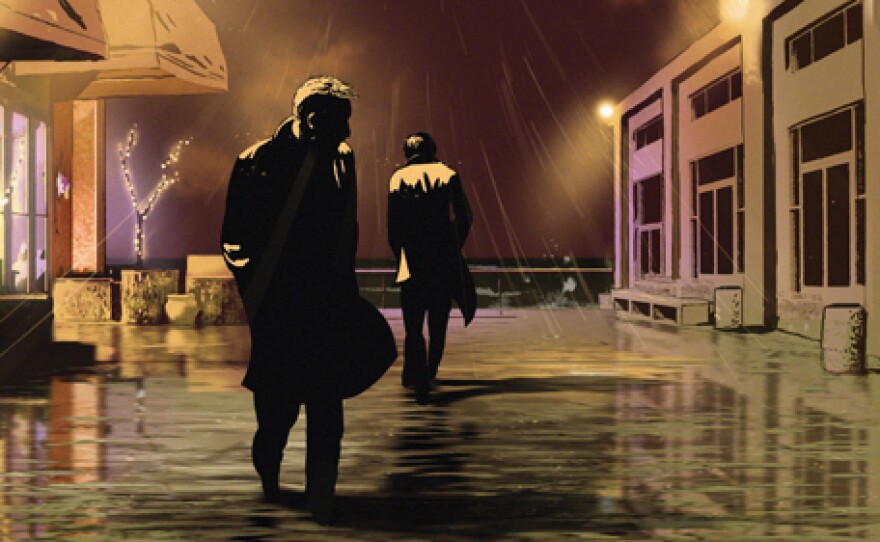In the early 1980s, the Israeli army invaded Lebanon and played a role in the massacre of Muslim men, women and children at refugee camps in South Lebanon. These events are at the elusive center of the animated documentary "Waltz with Bashir" (opening today at Landmark's La Jolla Village Theaters).
After a screening of "Waltz with Bashir" someone told me that he couldn't understand why filmmakers animate a story that could have just as easily been told in live action. But that's like asking why paint when you can take a photograph? And the answer lies in subjectivity. Animation or painting allow the artist complete control and provide him or her with an opportunity to convey a distinctly subjective point of view in a manner unlike live action film or a photograph. In the case of "Waltz with Bashir," subjectivity is key because filmmaker Ari Folman is dealing with memory. In the early 1980s, the Israeli army invaded Lebanon and played a role in the massacre of Muslim men, women and children at refugee camps in South Lebanon. These events are at the elusive center of these memories and at the heart of the animated documentary "Waltz with Bashir." I picked this film as the best animated film of the year after watching it on a screener in order to consider it for a critics' vote. But after seeing it on the big screen I think it's also deserving of a spot on my Ten Best List.
"Waltz with Bashir" opens with a vivid nightmare about 26 rabid dogs. The man recounting the dream explains that the dogs represent the ones he killed in Lebanon in 1982. The dream jolts filmmaker Ari Folman to realize that there's a gap in his memory about his own experiences as an Israeli soldier during the Lebanon War. So he seeks out friends, fellow soldiers, and a TV reporter in an attempt to reconstruct events.

Waltz with Bashir (Sony Pictures Classics)
On one level, "Waltz with Bashir" is a talking heads documentary with Folman conducting a series of interviews. But the lack of archival footage and the unwillingness of some to appear on camera prompted Folman to use animation to bring this journey to life. Folman felt animation was perfect because it exists, like memory, on the border of reality and the subconscious. The choice proves stunningly effective as recollections become hallucinatory visions. One friend describes the start of his tour of duty on what he calls the "Love Boat," and how that incongruous setting was the backdrop for a violent attack. Another soldier recounts a mission in the woods that goes bad when they encounter and kill a young boy with an RPG.
Folman uses a mix of rotoscoping (like in Richard Linklater's "Waking Life") and Flash animation to bring these memories to life. The style looks crude on the surface. Flat planes are layered on top of each other for something akin to moving comic book panels or a graphic novel by Joe Sacco ("Palestine, War's End"). Yet Folman chooses to emphasize certain details - a soldier's heaving chest, flies on the eye of a dead horse, what you see out of a tank's tiny window - to convey the subjectivity of each memory. Animation allows Folman complete control so he can steer our attention to exactly where he wants it. So as one soldier plays an air guitar to a revisionist take of Cake's song "I Bombed Korea," we get a montage of destruction from the soldier's point of view.

Waltz with Bashir uses rotoscoping and Flash animation (Sony Pictures Classics)
Folman's point may not be original. He concludes that the human psyche blocks out, transforms, and embellishes events in order for a person to cope with guilt or extreme situations. But it's the specifics of what's being blocked out here that makes the film compelling and unique. Folman essentially fills in the memory gaps we as viewers may have from the lack of media coverage these events generated.
A therapist explains to Folman that he and others may be suppressing memories of the refugee camp massacre because they "took on the role of a Nazi unwillingly." She goes on to explain how one soldier separated himself from the atrocities of the war by pretending to look at everything through a camera lens. This allowed him to distance himself from the horrors. And that's what Folman's film does. Folman accepts that film can be a cool medium. So he uses film as a distancing device that allows us to watch horrific events as surreal visions that seem far off.
But just as that soldier's camera eventually breaks, so too does Folman break his distancing device of animation as he cuts to real footage of women crying as they discover the bodies of slaughtered family members in the refugee camps. This then places the audience in the midst of real horrors that they can no longer ignore.
"Waltz with Bashir" (in Hebrew with English subtitles and rated R for some disturbing images of atrocities, strong violence, brief nudity and a scene of graphic sexual content)is a meticulously calibrated work. Folman functions much like the therapist who carefully leads a patient through a minefield of difficult memories and emotions, bringing together pieces bit by bit until we're ready to confront and accept the truth.
Companion viewing: "Waking Life," "West Beirut," "Assembly"






